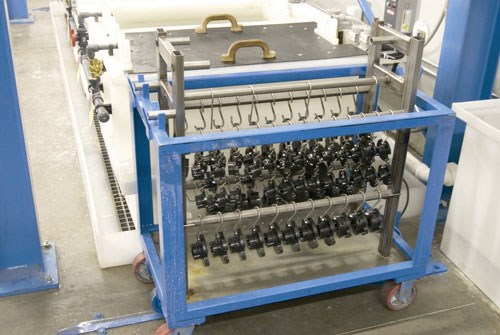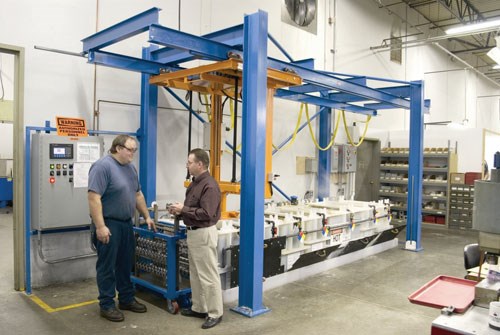Shop Saves Time, Money By Moving Part Finishing In-House
Today’s highly automated machining centers deliver completed parts faster than ever. However, once a part is machined, if the next step requires finishing, time gained on the machining end can be lost on the finishing end. This has changed for motion control component manufacturer Zero-Max Inc.
Today’s highly automated machining centers deliver completed parts faster than ever. However, once a part is machined, if the next step requires finishing, time gained on the machining end can be lost on the finishing end. This has changed for motion control component manufacturer Zero-Max Inc. The company recently installed an automated black oxide system that keeps pace with its machining operations while reducing finishing costs.
Birchwood Casey’s CNC Tru Temp black oxide finishing system has reduced machined part blackening time from 5 days to 1 and lowered part finishing costs from 20 cents to 4 cents for each component. In addition, it has completely eliminated all of the "hidden costs" associated with sending components outside for hot oxide finishing, says Ron Neff, Zero-Max vice president of manufacturing. Without additional labor, Mr. Neff reports, the automated finishing system provides consistent, high-quality black oxide finishes and even helps reduce machining center setups on select components.
During the past 50 years, Zero-Max has grown into a worldwide motion control solution provider. Its products are used in wind power generation, military vehicles, packaging systems and machine tools, to name a few. The company says improving its processes and delivering products in a timely manner has been key to its success. In keeping with these efforts, the shop recently conducted a study that identified its outsourced black oxide finishing as an area that needed improvement.
Results showed that in 1 year, Zero-Max issued almost 400 purchase orders averaging about 50 parts each for outside finishing. After factoring in the cost of the finishing and the time taken to issue a purchase order, following it through to the vendor and making payment, each purchase order cost about $240. And that figure didn’t take into account hidden costs such as grouping and wrapping parts to be sent out; time lost waiting for parts that were away for finishing; and receiving, sorting, inspecting and redistributing returned parts for assembly. Another hidden cost was machine setup time for parts that needed a final machining operation after blackening.
These factors led the shop to consider installing an in-house blackening system. Collaborating with Tru Temp manufacturer Birchwood Casey and automation builder Unifab Corporation, the company performed a cost-payback analysis that showed it would finish paying for the automated system within 18 months. Without adding labor, the company could perform low-temperature, black oxide finishing in-house without the hazards and pollution associated with traditional hot oxide processes. Factoring in these benefits, plus the hidden costs the company could eliminate, was compelling enough for the Zero-Max board to approve the project, Mr. Neff says. Implementing the Tru Temp system took less than 3 months.
Since installing the line less than a year ago, the shop has finished between 100 and 500 motion control components per 8-hour day with no extra labor. Zero-Max parts requiring the black oxide finish include coupling and torque limiter components machined out of 1215 steel. Tru Temp produces a satin black magnetite coating that is 0.5-micron thick with no effect on part dimension or material hardness. The finish can withstand 100 to 200 hours of neutral salt spray (ASTM B 117) or several hundred hours of humidity (ASTMD1748). This level of corrosion protection is important for both dealer storage and ocean shipment that meets Zero-Max product finish
requirements.
The system uses a programmable hoist that moves iron and steel components through the Tru Temp low-temperature black oxide process in a 28-minute cycle. Designed for high-volume, continuous service, the system consists of a line of eight processing tanks for alkaline soak cleaning, rinsing, surface preparation, application of the black oxide and other steps in the process. The hoist picks up a load of unfinished parts from the pickup station, processes it through the appropriate chemical tanks and then deposits the finished load at the drop-off station at the other end of the line. The hoist program can process 6,000 lbs of parts per 8-hour shift.
Constructed of white polypro, each processing tank is equipped with supports under the top lid to handle the extra weight of the flight bar when the hoist drops off a load of parts. The tanks are pre-plumbed with half-inch water lines and ball valve controls. Setdown saddles automatically center part loads within each station. The hoist and welded steel superstructure have a 500-lb capacity. Powered by an AC, single-speed motor/brake with nylon belt lift, the system operates via an Allen Bradley PLC digital control with a manual joystick backup. The hoist controller has a separate, touchscreen control panel.
To minimize part movement, the system is located between machining centers and assembly cells. The process is automatic from start to finish, so no monitoring is needed other than simple observation when a part load is completed and moved back for finish machining or for assembly and packaging. This keeps part handling to a minimum.
The company uses wheeled carts that carry racks loaded with as many as 60 parts to move components in and out of the Tru Temp line. An operator in the deburr/parts washer department loads the racks with raw parts and wheels the cart into the pickup station of the black oxide line. Once there, the hoist senses the presence of the load and picks it up for processing. At the end of the line, the finished load is deposited in the drop-off station and wheeled via cart to inspection/assembly.
To reduce maintenance, the Tru Temp process is designed for long bath life without the need for routine dumping. At Zero-Max, a department supervisor performs solution monitoring and control via a color-change test that indicates proper concentration level, a process that takes less than half an hour. The finishing system contains no EPA-regulated chemicals, so the shop has no need for waste treatment equipment—only pH adjustment prior to discharge directly into the sewer.
"We’ve cut black oxide costs and reduced component inventory levels based on the new lead times brought about by same-day finishing," Mr. Neff says. "That frees up cash for other uses. But the most important benefit is eliminating the 5-day turnaround time and getting product to our customers faster."
Read Next
Do You Have Single Points of Failure?
Plans need to be in place before a catastrophic event occurs.
Read More5 Aspects of PMTS I Appreciate
The three-day edition of the 2025 Precision Machining Technology Show kicks off at the start of April. I’ll be there, and here are some reasons why.
Read MoreA Tooling Workshop Worth a Visit
Marubeni Citizen-Cincom’s tooling and accessory workshop offers a chance to learn more about ancillary devices that can boost machining efficiency and capability.
Read More











.jpg;maxWidth=300;quality=90)









